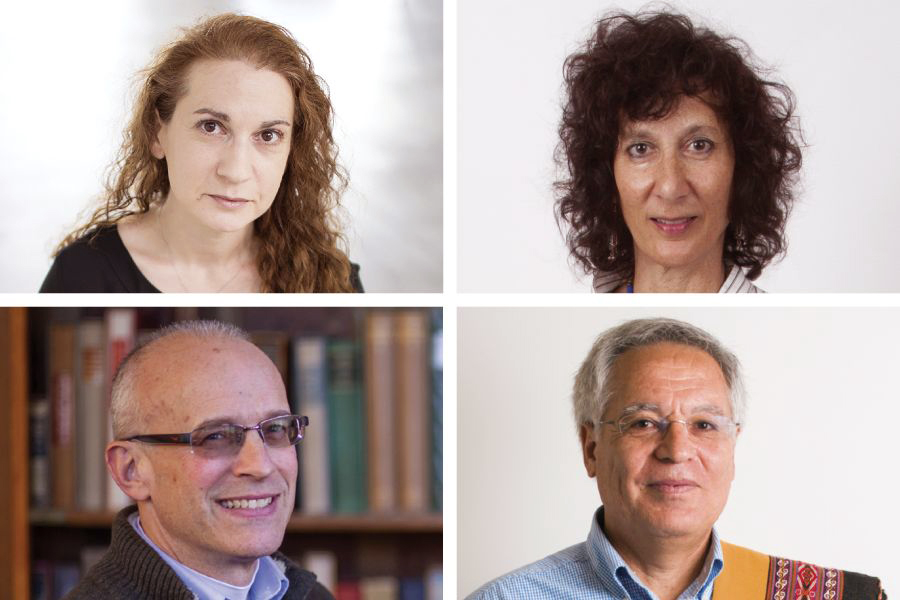
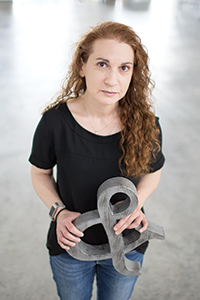
Monica Berlin ’95
Richard P. & Sophia D. Henke Distinguished Professor of English
Specializes in: Poetry, creative writing, 21st century American literature
At Knox since: 1998
What does being named the Richard P. & Sophia D. Henke Distinguished Professor mean to you?
I am humbled, knocked over really. Not a day goes by when I don’t recognize the extraordinary company I keep: brilliant peers, brilliant students, esteemed alumni and friends. This coming fall will mark thirty years of my being here, and in my own small way I guess I’m now a part of the history of the College, a place and an ethos deeply ingrained in my being in the world. Every day that I walk into Old Main, or stand at my office window high up in that building, I know well the footsteps I follow, the giants who led the way, the sacrifices others have made for me to be here. So, yes, I am humbled to be considered by the institution worthy of such recognition, and humbled by my colleagues whose recommendation led to the distinction, and moved by the Henke’s generosity and belief in Knox. As I told Dr. Henke, I hope to honor their commitment as I carry their name alongside my own.
Do you have a particular favorite course to teach? If so, what is it and what do you like so much about it?
Nearly every class I teach is my favorite at the moment I’m teaching it, and in memory, when I look back on a term or a year, that’s also true. So, a better answer: I don’t really play favorites. I love all my courses and equally, even as each carries its own distinctions. What distinguishes one class from another tends to be the students in the room, the conversations we have and that their work encourages. A course stands out differently in memory when the news of the day and the weather and the books we are reading all speak to the students, and to the students’ writing, and to the things we haven’t yet figured out how to say.
What’s the most difficult part of teaching [creative writing]?
Less a difficulty than a unique challenge, our primary work is the work of making art and then learning to discuss a particular piece of art by considering craft and form, tradition and innovation, and we perform that work recognizing that art is also a means of expression, that sometimes we write something down to figure out what that something is or means or how we feel about it. So, in the writing classroom, we have to find a necessary balance of exploring the tools of craft, trying to figure out how a thing is made and remembering that that made thing was made by someone in front of us who is real and learning and human and sensitive, and we do all that through language, which is, in its very nature and by design, subjective, flawed, even rickety. And then, there is also the fact that in preparing a writing course, our primary texts are always new, are almost always in process, evolving, and again, made by writers still finding their way.
What are a couple of items remaining on your professional bucket list?
I want to wake up every day and make a poem. I want to want to make a poem every day. I want to read poems other people have made. I want to look at art. I want to continue to be in a community that values the arts, honors the arts, and that makes room and offers resources and support for the arts, that recognizes that all the remarkable parts of our lives are made in tandem with art making. I want to be in rooms with other people talking about art, and making art, and I want to be in rooms with people who recognize the ways in which we can make a life with art at the center, and that that life can matter. So, I’d like to continue doing what I have done all these years here, which is that I’ve been supported in my writing, and have supported others in making writing, and part of that support has manifested in my very clear and urgent belief that we don’t know always know where our next poem (or story or essay or work of art) will come from but that if we exist in environments that allow us to follow our curiosities, that encourage us to follow those curiosities and that trust us to do so to our fullest, that we will exceed our own expectations, will discover something we hadn’t known we needed or needed to say.
All of which is to say, honestly, I don’t keep a bucket list, or I don’t think that I do. “All the poems of our lives are not yet made,” the great Muriel Rukeyser wrote, and that sentiment is really at the forefront of my thinking about my creative life, my professional life. I don’t yet know what those poems are, but I want to continue to be allowed and encouraged to follow whatever impulse feels urgent, feels essential. Okay, and also, I want to make a poem or an essay that replicates, formally, how a Rube Goldberg machine functions or that enacts itself the way the best Buster Keaton’s sequences do.
What are you optimistic about, professionally and/or personally?
O, hm. Well, I have extraordinary faith in our students, in our alumni, in our faculty. I believe in people, and am hopelessly optimistic about art, what art can do and does and its resilience, its ability to demonstrate its value and worth and necessity.
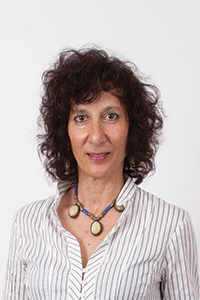
Lynette Lombard
Chancie Ferris Booth Distinguished Professor of Art
Specializes in: Landscape painting, feminist theory and modernism, contemporary painting, printmaking, and drawing
At Knox since: 1990
What does being named to the Chancie Ferris Booth Professorship mean to you?
It means a great deal! I was completely and utterly thrilled and surprised to have received President Amott’s phone call announcing I was the recipient of the Chancie Ferris Booth Professorship! Never in a million years did I expect to receive a named professorship. I feel deeply honored.
You’ve been teaching at Knox since 1990. What are a couple of the most important developments in your teaching style over that time?
Where should I start?! I like the intellectual freedom that Knox gives faculty, encouraging all of us to teach courses that are engaging and are critical to our discipline within the liberal arts. Students are always challenging and take me out of any comfort zone I think I have. One of the things I love about teaching is that it’s unpredictable; you never know how students are going to respond to an idea or how a class dynamic exerts a particular energy and sense of community.
Developments: I think over time I’ve accrued a wide range of experiences teaching and I have developed my preferences and my point of view. I know what strategies work for me in terms of presenting ideas, assignments and projects as clearly as possible, in order to enliven and energize students and their work. Teaching in the arts involves a lot of one-on-one meetings and discussion. While there is a constant focus in my teaching on visual form as a language which expresses ideas and feelings, I try to be open to each individual student’s strengths, points of view and what they need to work on. But also teaching involves the whole class dynamic and understanding the class as a community, working through sometimes demanding assignments together. I think of a class as a supportive safety net for taking risks into new intellectual and emotive spaces. Students have told me I’m quite passionate about the ideas and methodologies I present and I’m sure that’s true for all of the Knox faculty. We teach what we believe in.
I never really teach the same course in the same way. I find I want to present the material in a new way, so I change my strategies and some of the content. What I teach has to feel urgently important and current. This is to keep the ideas meaningful.
In my time at Knox and teaching on summer courses or being a visiting artist at another institution, I return to Knox and think the students who stand out at Knox are extraordinary: intellectually inquisitive, hard-working, responsible and willing to take imaginative leaps to push their work. During the pandemic, teaching remotely has been challenging and frustrating. Students are struggling in all manner of ways. We are all awaiting the vaccine to return to the studio/classroom safely. However, I think technology will inevitably become a more prevailing component of our teaching practices in the future.
Do you have a particular favorite course to teach? If so, what is it and what do you like so much about it?
My favorite course to teach? Generally, I like all the courses I teach, especially the ones I’m teaching right now, which are Open Studio and Painting 213. The demands of teaching the advanced classes is about challenging students on a deeper level, assisting and directing them to find what has meaning for them and how they construct that complexity visually and materially.
I love teaching drawing, which is the scaffolding for any art form. I love the directness of drawing from life: translating what you see onto a piece of paper, using only black, white and gray materials and teaching how to construct within the rectangle: how dynamic, ancient and contemporary that is!
Another course I like to teach is Knox in New York, which will be offered hopefully in the fall of 2021, once everybody has been vaccinated. It’s a course that involves teaching art history from an artist’s point of view, and a course that combines academic and studio practice. I think it’s always a transformative course. Students can envision themselves in an art world career. We go to all the major museums, many galleries, artist’s studios, meet alums and attend lectures. It’s a very rich experience and we’re always exhausted and exhilarated when we return to campus.
What’s the most difficult part of teaching landscape painting?
This is another one of my favorite courses to teach since it’s closely related to what I do as a painter. Usually, there are two things that are demanding: one involves the complexities of translating what you see into a visual form. And then secondly, there is the experience of being outdoors. The first few classes (since the course always is in the spring) are a test of endurance and most students are absolutely amazing- they’re willing to go outside: wear gloves, a hat, several socks and protective gear and paint in the snow, cold or rain. Since there’s a real urgency, their paintings are fresh, very direct and confident. By the time we’re talking about 20th and 21st spatial constructions, their work is taking imaginative but informed leaps and the results can be remarkably inventive.
What are a couple of items remaining on your professional bucket list?
I have a long list of places I’d like to paint: India, Australia, Patagonia and so many other places and return to Spain and Ireland. I look forward to showing my work in more venues and I would also like to curate a few art shows and continue to interview artists.
What are you optimistic about, professionally and/or personally?
Human resiliency. I hope the pandemic has taught us to work together to find solutions to problems collaboratively, to be more compassionate, to give greater emphasis to spending more time with friends, family, pets and doing what you love and to work towards restoring and stewarding the flora and fauna of the nature that remains.
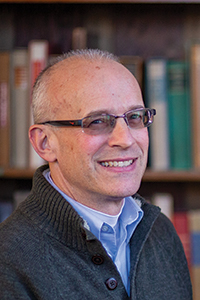
Andrew Mehl
George Appleton Lawrence Distinguished Service Professor of Chemistry
Specializes in: Biochemistry, proteins and enzymes; biological spectroscopy
At Knox since: 1993
What does being named to the George Appleton Lawrence Distinguished Service Professorship mean to you?
This is an honor to be named to this Professorship. I feel honored that my fellow colleagues nominated me for this professorship.
You’ve been teaching at Knox since 1993. What are a couple of the most important developments in your teaching style over that time?
Patience- early own I covered the material too quickly, I think I’ve developed a good pace so that students can reflect and ask questions. I think I’ve developed a good feel for when students are struggling with the material and I know when to spend a longer time with certain concepts.
Do you have a particular favorite course to teach? If so, what is it and what do you like so much about it?
BCHM 302—The Chemistry of Metabolism. This is always fun to teach because I can always relate the material to something everyone likes: Food! And discussing how the components that comprise food—protein, carbohydrates, etc. are utilized by our metabolic pathways. Discuss how certain diets relate to metabolism is always interesting.
General chemistry—to see the excitement when a student understands something new and this sparks an interest in chemistry/biochemistry.
What’s the most difficult part of teaching chemistry?
Keeping the material interesting for students. The basic concepts have to be learned first before you can understand and appreciate the later, more interesting material.
What are a couple of items remaining on your professional bucket list?
It would be nice to see additional spaces in SMC renovated. We have a wonderful new A-Core! I’d love to help with future renovations.
What are you optimistic about, professionally and/or personally?
Thankful that I can continue to carry out research and involve students with my research endeavors.
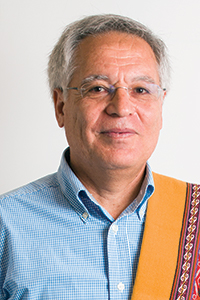
Julio Noriega
Burkhardt Distinguished Chair in Modern Languages (Spanish)
Specializes in: Spanish-American migrant literature and indigenous cultures of America
At Knox since: 2009
What does being named to the Burkhardt Distinguished Chair in Modern Languages mean to you?
To my mind, being named the Burkhardt Distinguished Chair in Modern Languages is an invaluable recognition of my work by colleagues and peers at Knox College. I feel honored to be counted among past and present colleagues, with impressive accomplishments, who earned this award before me. Within the Department of Modern Languages, and Literatures, Professors Bruce Davis and Jessie Dixon were the early winners of this award. At this stage of my career, I promise to continue working hard to keep their legacy alive and to meet further expectations of our department.
You’ve been teaching at Knox since 2009. What are a couple of the most important developments in your teaching style over that time?
Knox College has given me a great opportunity to develop a teaching style that I was unable to adopt while serving in other institutions of higher education. For example, by directing the Barcelona Program from 2013 to 2015 and by chairing the Latin American Studies Program from 2017 to the present, both positions have helped me to gain a better understanding of my role as a Spanish language, culture, and literature instructor. Because of my experience in Barcelona, I was able to craft and implement successfully in Fall 2016 a travel component of my course entitled Cultures of Spanish Speaking World-Andean Class. This course comprises a two-week study trip to Peru. Thus, in Fall 2016, I took a group of students to Peru to discover the Andean world. My efforts to explore new avenues to expand the Latin American Studies curriculum led me to incorporate in our program the Bilingual Indigenous Literature in the Americas. I am currently offering this course with the future goal of including trans-indigenous studies in our Latin American Studies Program. In short, I would say that I expanded the classroom-oriented teaching style to embrace a teaching style that is student-centered, and interdisciplinary in nature. Consequently, I am more confident teaching outside the classroom and participating in interdisciplinary and international workshops, seminars, and collective projects. I highly recommend this teaching style especially for classes offered remotely.
Do you have a particular favorite course to teach? If so, what is it and what do you like so much about it?
I have no preference in terms of schedule or specific courses to teach provided they are related to the area of my expertise. I enjoy teaching any time of the day beginning, intermediate or advanced level courses in our Spanish curriculum. It is just as important for me to serve students who are enrolled to satisfy the elements requirement as to serve those specializing in Spanish. I believe that my primary role is to serve to the best of my abilities our departmental needs and our students’ interests.
What’s the most difficult part of teaching Spanish and/or Latin American literature?
I would say that the most challenging part of these courses is to replicate in the classroom not only the complexity but also the uniqueness of the Latin American social and cultural situation. No matter what bibliographical or media source you use as evidence, there is always a risk of overly simplifying or misrepresenting the pressing and conflictive realities of an area where multi-ethnic traditions and languages intertwine. This challenge could be mitigated in part when there is a travel component option added to our curriculum. I earnestly believe that direct and presential observations are crucial if I want my students to truly grasp the compelling realities of the Latin American world.
What are a couple of items remaining on your professional bucket list?
I have three major projects to accomplish in the following order of priorities: 1) The formal curricular implementation of two new 300 level courses namely New York in the Writing of Hispanic Migrants and Bilingual Indigenous Literature in the Americas; 2) Adding the trans-indigenous studies to the Latin American Studies Program, and 3) Completion of a book-length manuscript on transatlantic indigenous short stories.
What are you optimistic about, professionally and/or personally?
I am an optimist that we at Knox will survive this pandemic period and will be strengthened to make Knox one of the most prestigious and compassionate higher institutions. I would also simply like to express my sincere gratitude to the Knox College family for all the appreciation and support I have been receiving since I got here.